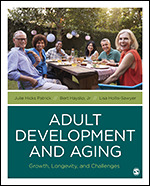Preface
Publisher’s Acknowledgments
About the Authors
Chapter 1: Studying Growth and Change Across the Life Span
Principles of Life Span Development
The Multidimensional Nature of Age
Developmental Research Methods: Disentangling Chronological Age, Historical Period, and Generational Cohort
Chapter 2: Biological Aging, Health, and Longevity
Why Do We Age? Theories of Biological Aging
Age-Related Changes in Vison
Age-Related Changes in Audition
Age-Related Changes in Gustation
Age-Related Changes in Olfaction
Age-Related Changes in Somesthesis
Specific Chronic Health Conditions
Everyday Experience of Biological Aging
Life Expectancy and Life Span
From Theory to Application: Life Extension and Health Span
Integrating Across Topics
Chapter 3: Cognitive Development Across Adulthood
Crystallized (Gc) and Fluid (Gf) Abilities
Seattle Longitudinal Study and Primary Mental Abilities
Information-Processing Approaches to Cognition
Noncognitive Influences on Cognitive Aging
Optimizing Cognition in Adulthood
Other Frameworks Related to Cognitive Aging
Chapter 4: Coping and Resiliency in Adulthood
Life Events as Causes of Change
Stress and Coping in Adulthood
Coping With Loss in Adulthood: An Overview
Influences on How We Cope With Loss: How Death Is Defined
The Meaning We Attach to Death and Dying Influences How We Cope With Loss
Responses to Death and Dying as Influences on Coping With Loss
Coping With and Surviving Loss
Chapter 5: Personality and Emotional Regulation
Defining Personality in Adulthood
Stability and Change: Stage and Non-Stage Theories of Traits
The “Big Five” and Other Personality Models
Observable Behaviors and Impression Management
Resiliency in Adjustment to Aging
Defining Emotional Regulation in Later Life
Emotional Intelligence and Self-Control
Self-Determination and Personal Growth
Different Emotional Coping Styles and Strategies
Emotional Adaptation to Aging-Related Losses and Changes
Therapeutic Interventions to Support Positive Aging Adjustment
Chapter 6: Mental Health and Intervention
Mental Health in Adulthood
The Course of Alzheimer’s Disease
Mild Cognitive Impairment
Disorders That Mimic Dementia
Common Functional Disorders
The Mental Health Challenges Faced by College Students
Other Functional Disorders
Drug Use and Abuse Among Younger and Older Persons
Therapeutic Interventions With Adults and Older Persons
Goals for Therapy With Adults
Therapies With Adults and Older Persons
Chapter 7: The Social-Environmental Context of Adulthood and Aging
Understanding and Describing the Environment
Transactions With the Environment
Person-Environment Interaction
Adult Development in Context
Influences on the Developmental Niche in Adulthood: The Healthy and Not-So-Healthy
Real-Life Applications of Person- Environment Fit and Developmental Niche
Making Choices About Alternative Paths of Adult Development
Developmental Tasks in Adulthood: Young Adulthood
Developmental Tasks in Adulthood: Middle Adulthood
Developmental Tasks in Adulthood: Late Adulthood
Older Adults’ Involvement in the Community
Enhancing Older Persons’ Use of Services and Programs
Person-Environment Fit and Quality of Life in Late Adulthood
Societal Intervention as Environmental Change
Chapter 8: Interpersonal Relationships: Our Personal Network of Support
Technology and Social Support
Aging and Convoy Membership
Functions of Social Convoys
Negative Interpersonal Interactions
Intergenerational Relationships: A Key Dimension of Our Convoy of Support
Functions of Intergenerational Relationships
Intergenerational Exchanges of Help and Assistance: Parents and Adult Children
Caregiving in an Intergenerational Context
Grandparents as Caregivers
Gender Differences in Social Support
Cultural Variations in the Intergenerational Kinship Network
Educational Implications of Intergenerational Relationships
Interest-Related and Deep Friendships
Remarriage Among Widows and Widowers
Grandparents Raising Their Grandchildren
Chapter 9: Socialization and the Family
Defining Socialization in Adulthood
Socializing Effects of Age (Cohort), Gender, and Culture
Interpersonal Relationships in Adulthood
Partner Selection and Marriage
Relationship Satisfaction
Defining Family in Later Life: Biological and Nonbiological Ties
Aging Family Roles and Transitions
Structural Changes and Adaptations: Divorce, Remarriage, and Blended Forms
Grandparenting and Second Parenthood
Social Networking and the Use of Social Media
Chapter 10: Work
Current Workforce Trends in the United States and Other Industrialized Nations
Career Trajectories and Transitions Affecting Aging
Situational, Cultural, and Cohort Factors Influencing Workforce Participation
Work-Related Stressors and Adaptation Efforts
Skill Updating to Avoid Obsolescence and Job Loss
Discouraged Older Worker Syndrome and Resilience
Ageism, Age Discrimination, and Older Workers’ Rights and Responsibilities
The Future of an Aging Workforce: National and Global Trends
Chapter 11: Retirement
Concepts/Theories Explaining Retirement Motivation
Types of Retirement Options and Associated Experiences
Health Factors and Gender Differences: Retirement Timing
Preretirement Attitudes and Retirement Preparation
Outcomes From Retirement: Short- and Long-Term Effects
Public Policy and Future Retirement Support Resources: A Cost-Benefit Analysis
Chapter 12: Aging Well: Promoting Healthy Development Across the Life Span
A Brief History of Successful Aging
Successful Aging Versus Healthy Aging
Heterogeneity and Healthy Aging
Multidisciplinary Supports for Healthy Aging
Glossary
References
Index

